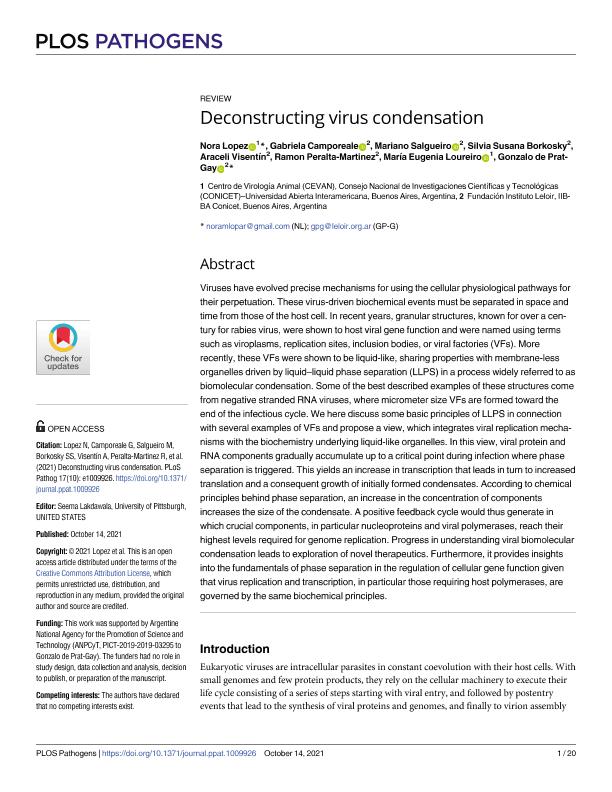Artículo
Deconstructing virus condensation
Lopez, Nora Mabel ; Camporeale, Gabriela
; Camporeale, Gabriela ; Salgueiro, Mariano
; Salgueiro, Mariano ; Borkosky, Silvia Susana
; Borkosky, Silvia Susana ; Visentin, Araceli Natalia
; Visentin, Araceli Natalia ; Peralta Martínez, Ramón; Loureiro, Maria Eugenia
; Peralta Martínez, Ramón; Loureiro, Maria Eugenia ; de Prat Gay, Gonzalo
; de Prat Gay, Gonzalo
 ; Camporeale, Gabriela
; Camporeale, Gabriela ; Salgueiro, Mariano
; Salgueiro, Mariano ; Borkosky, Silvia Susana
; Borkosky, Silvia Susana ; Visentin, Araceli Natalia
; Visentin, Araceli Natalia ; Peralta Martínez, Ramón; Loureiro, Maria Eugenia
; Peralta Martínez, Ramón; Loureiro, Maria Eugenia ; de Prat Gay, Gonzalo
; de Prat Gay, Gonzalo
Fecha de publicación:
10/2021
Editorial:
Public Library of Science
Revista:
Plos Pathogens
ISSN:
1553-7366
e-ISSN:
1553-7374
Idioma:
Inglés
Tipo de recurso:
Artículo publicado
Clasificación temática:
Resumen
Viruses have evolved precise mechanisms for using the cellular physiological pathways for their perpetuation. These virus-driven biochemical events must be separated in space and time from those of the host cell. In recent years, granular structures, known for over a century for rabies virus, were shown to host viral gene function and were named using terms such as viroplasms, replication sites, inclusion bodies, or viral factories (VFs). More recently, these VFs were shown to be liquid-like, sharing properties with membrane-less organelles driven by liquid–liquid phase separation (LLPS) in a process widely referred to as biomolecular condensation. Some of the best described examples of these structures come from negative stranded RNA viruses, where micrometerAU size: VFs PerPLOSstyle are formed ; micronshouldbechangedtom toward the end of the infectious cycle. We here discuss some basic principles of LLPS in connection with several examples of VFs and propose a view, which integrates viral replication mechanisms with the biochemistry underlying liquid-like organelles. In this view, viral protein and RNA components gradually accumulate up to a critical point during infection where phase separation is triggered. This yields an increase in transcription that leads in turn to increased translation and a consequent growth of initially formed condensates. According to chemical principles behind phase separation, an increase in the concentration of components increases the size of the condensate. A positive feedback cycle would thus generate in which crucial components, in particular nucleoproteins and viral polymerases, reach their highest levels required for genome replication. Progress in understanding viral biomolecular condensation leads to exploration of novel therapeutics. Furthermore, it provides insights into the fundamentals of phase separation in the regulation of cellular gene function given that virus replication and transcription, in particular those requiring host polymerases, are governed by the same biochemical principles.
Palabras clave:
Virus
,
Replicación
,
Biofísica
,
Separación de fases
Archivos asociados
Licencia
Identificadores
Colecciones
Articulos(IIBBA)
Articulos de INST.DE INVEST.BIOQUIMICAS DE BS.AS(I)
Articulos de INST.DE INVEST.BIOQUIMICAS DE BS.AS(I)
Citación
Lopez, Nora Mabel; Camporeale, Gabriela; Salgueiro, Mariano; Borkosky, Silvia Susana; Visentin, Araceli Natalia; et al.; Deconstructing virus condensation; Public Library of Science; Plos Pathogens; 17; 10; 10-2021; 1-20
Compartir
Altmétricas



